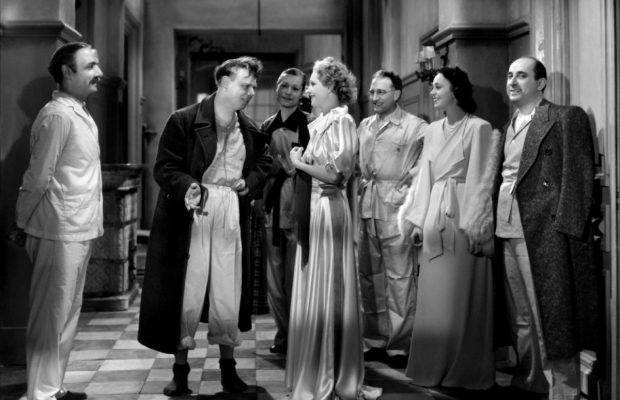The Rules of the Game [La Règle du Jeu] (1938)

Toronto Film Society presented The Rules of the Game [La Règle du Jeu] (1938) on Monday, October 15, 1951 as part of the Season 4 Main Series, Programme 1.
FIRST EXHIBITION MEETING – FOURTH SEASON
Monday, October 15, 1951 8.15 p.m. sharp
Royal Ontario Museum Theatre
NOTE: Members who took out double memberships are reminded to inform their partners about each programme. Those not receiving programme notes by mail may obtain their copies at the theatre.
_________________________________________________________________________
OPENING REMARKS
Miss Nola Holdaway, President
The Undefeated (Great Britain 1950)
DIRECTOR: Paul Dixon
PRODUCER: James Carr, Central Office of Information for the Ministry of Pensions
SCRIPT: Paul Dixon and Ted Willis
PHOTOGRAPHY: Ronald Anscombe
EDITOR: Francis Cockburn
MUSIC: Lambert Williamson
This is an intelligent competent film designed both to emphasise the achievements of the Ministry of Pensions, and to show the problems of the disabled, and the skill and courage with which these are overcome. Roger Manvell described it as one of the top films shown at the Edinburgh Film Festival last year, “By the nature of its subject it is an affecting film, but the treatment of a particular case, a man whose injuries are accompanied by psychological difficulties, personalises all the issues involved in the Ministry’s particular service. There is, of course, nothing new about this technique, but it is well done and the necessary time is allowed to make the audience feel with as well as about this man and his wife in their successful struggle against extreme human difficulties.”
INTERMISSION
10 minutes
La Règle du Jeu (The Rules of the Game) France 1938 84 mins
DIRECTOR: Jean Renoir
PRODUCER: Claude Renoir
SCRIPT: Jean Renoir and Koch
PHOTOGRAPHY: Bachelet, Jacques Lemare, Alphen and Alan Renoir
EDITORS: Marguerite Renoir and Mme. Huguet
MUSIC: Roger Desormière from Mozart, Monsigny and Saint-Saens
ART DIRECTORS: Lourié and Max Douy
CAST: Dalio, Nora Gregor, Jean Renoir, Roland Toutain, Mila Parély, Paulette Dubost, Carette, Gason Modot, Pierre Magnier, Eddy Debray, Pierre Nay, Odette Talazac, Francoeur, Clair Gérard.

La Règle du Jeu is probably Renoir’s masterpiece. It was the last film he made in France, and its lukewarm reception is supposed to be one of the reasons he left for Hollywood. The cause of its unpopularity at the time is not difficult to understand, for its picture of a certain level of French society is remarkably unsparing. Although Renoir disclaimed any desire to present a social study and in fact calls the film a divertissement, its moralistic power is undeniable.
La Règle du Jeu tells the story of a week-end spent in a country chateau by a party of lively, easy-going, unprincipled people. They are not vindictive or pathological: if not rich, they are still elegant and charming. Their “sin” is something much less obviously abnormal. It consists of having no values at all, of always avoiding important issues. Theus they see love in terms of flirtation or adultery; it is enough to profess honest rather than practise it, to skate gracefully over difficulties rather than solve them. La Règle is in fact the rule of the Lie. …
As well as writing and directing this remarkable film, Renoir plays a leading role in it. In style it lacks the astonishing polish and virtuosity of Panique, the Clouzot films; it does not extend the visual resources of the cinema in the way that so distinguishes Les Jeux Sont Faits: the construction is not quite perfect; but why, in the last analysis, it is more impressive and satisfying than any of these later films is because it does not set out deliberately to show that unworthiness and disastrous impulses are hidden beneath the surface of life. There is no sense of failure and bitterness, no insistence on viciousness, from the start. The characters bring themselves to tragedy by acting, what is to them, in good faith. Thus one may pity them, one likes to remember their moments of pleasure and goodwill–and on the whole a belief in humanity, however sorely tried, produces the most lastingly satisfactory art.
Notes by Gavin Lambert
A Dog’s Life (U.S.A. 1918)
WRITTEN AND DIRECTED by Charles Chaplin
PHOTOGRAPH by Rollie Totheroh
CAST – Edna Purviance, Chuck Reisner, Henry Bergman, Albert Austin
The first picture Chaplin made for First National release as his best comedy to date, containing in full bloom all the technique he had perfected in the past four years. The pathos is stressed more than ever in Charlie’s attempts to lead a free independent existence. The title, like most of his subsequent titles, was significant and symptomatic of the social consciousness that was to permeate his future productions more deliberately than heretofore. Made soon after America’s entrance into the World War, A Dog’s Life showed Chaplin as a vagabond philosopher, a Walt Whitman of the screen, a characterization that afforded him ample opportunity to prick the bubbles of social conventions and show up humbuggeries, and that he later adopted repeatedly. Its underlying theme was also typical of Chaplin: living is, for the common man, a dog’s life, but that is no excuse for not making the best of it.
An Index to the Films of Charles Chaplin – Theodor Huff
_________________________________________________________________________
ANNOUNCEMENTS
RESULTS OF MEMBERS’ VOTES ON LAST SEASON’S FILMS
Best features (in order of preference):
Day of Wrath
Passion of Joan of Arc
Childhood of Maxim Gorky
Poorest features:
Broken Blossoms
Fall of the House of Usher
Most worthwhile documentaries or short films:
Night Mail
Images Medievales
Le Tonnelier and Out of a Chinese Painting Brush
Least worthwhile documentaries or short films:
At Land
Mouvement Perpétuel
Dream of a Rarebit Fiend
NEXT EXHIBITION MEETING: NOV. 12:
Rien Que Les Heurs Cavalcanti 1926
Le Million René Clair 1931










Leave a Reply